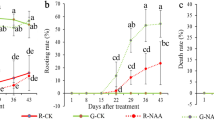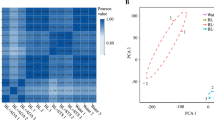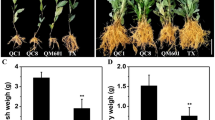Abstract
The generation of adventitious roots (ARs) is the key to the success of cuttings. The appropriate environment for AR differentiation in tea plants is acidic. However, the mechanism is unclear. In this study, pH 4.5 was suitable condition for the differentiation of AR in tea plants. At the base of cuttings, the root primordia differentiated ARs more rapidly at pH 4.5 than pH 7.0, and nine AR differentiation-related genes were found to be differentially expressed in 30 days, the result was also validated by qRT-PCR. The promoter regions of these genes contained auxin and brassinosteroid response elements. The expression levels of several genes which were involved in auxin and brassinosteroid synthesis as well as signaling at pH 4.5 compared to pH 7.0 occurred differential expression. Brassinolide (BL) and indole-3-acetic acid (IAA) could affect the differentiation of ARs under pH 4.5 and pH 7.0. By qRT-PCR analysis of genes during ARs generation, BL and IAA inhibited and promoted the expression of CsIAA14 gene, respectively, to regulate auxin signal transduction. Meanwhile, the expression levels of CsKNAT4, CsNAC2, CsNAC100, CsWRKY30 and CsLBD18 genes were up-regulated upon auxin treatment and were positively correlated with ARs differentiation.This study showed that pH 4.5 was the most suitable environment for the root primordia differentiation of AR in tea plant. Proper acidic pH conditions promoted auxin synthesis and signal transduction. The auxin initiated the expression of AR differentiation-related genes, and promoted its differentiated. BL was involved in ARs formation and elongation by regulating auxin signal transduction.
Key message
Acidic environments promote auxin synthesis and regulate root primordia differentiation to form ARs by initiating AR differentiation-related genes expression in Camellia sinensis.






Similar content being viewed by others
Data Availability
The dataset used and/or analyzed in this study can be obtained from the author according to reasonable requirements.
References
An H, Zhang J, Xu F, Jiang S, Zhang X (2020) Transcriptomic profling and discovery of key genes involved in adventitious root formation from green cuttings of highbush blueberry (Vaccinium corymbosum L.). BMC Plant Biology 201:1–14. https://doi.org/10.1186/s12870-020-02398-0
Bao F, Shen J, Brady SR, Muday GK, Asami T, Yang Z (2004) Brassinosteroids interact with auxin to promote lateral root developmentin Arabidopsis. Plant Physiol 134:1624–1631
Barbezab Elke, Dünserb Kai, Gaidoraa Angelika, Lendla Thomas, Buschac Wolfgang (2017) Auxin steers root cell expansion via apoplastic pH regulation in Arabidopsis thaliana. Proc Natl Acad Sci. 5:E4884–E4893. https://doi.org/10.1073/pnas.1613499114
Bellini C, Pacurar DI, Perrone I (2014) Adventitious roots and lateral roots: similaritiesand diferences. Annu Rev Plant Biol. 65:639–666. https://doi.org/10.1146/annurev-arplant-050213-035645
Cao X, Du W, Shang C, Shen Q, Liu L, Cheng J (2018) Comparative transcriptome reveals circadian and hormonal control of adventitious rooting in mulberry hardwood cuttings. Acta Physiol Plant 4011:1–16. https://doi.org/10.1007/s11738-018-2772-y
Chaiwanon Juthamas, Zhi-Yong Wang (2015) Spatiotemporal Brassinosteroid Signalingand Antagonism with Auxin PatternStem Cell Dynamics in Arabidopsis Root. Curr Biol 25:1031–1042. https://doi.org/10.1016/j.cub.2015.02.046
Clouse SD, Sasse JM (1998) BRASSINOSTEROIDS:essentialregulators of plant growth and development. Annu Rev Neurosci 49:427–451
Cooper WC (1936) Transport of root-forming hormone in woody cuttings. Plant Physiol 114:779. https://doi.org/10.1104/pp.11.4.779
Damiano C, Padro MDA, Frattarelli A (2008) Propagation and establishment in vitro of myrtle (Myrtus communis L.), pomegranate (Punica granatum L.) and mulberry (Morus alba L.). Propag Ornam Plants 81:3–8
Devi J, Kaur E, Swarnkar MK, Acharya V, Bhushan S (2021) De novo transcriptome analysis provides insights into formation of in vitro adventitious root from leaf explants of Arnebia euchroma. BMC Plant Biol 211:1–16. https://doi.org/10.1186/s12870-021-03172-6
Ding ZJ, Yan JY, Li CX, Li GX, Wu YR, Zheng SJ (2015) Transcription factor WRKY46 modulates the development of Arabidopsis lateral roots in osmotic/salt stress conditions via regula-tion of ABA signaling and auxin homeostasis. Plant J 84:56–69. https://doi.org/10.1111/tpj.12958
Druege U, Franken P, Hajirezaei MR (2016) Plant hormone homeostasis, signaling, and function during adventitious root formation in cuttings. Front Plant Sci 7:381. https://doi.org/10.3389/fpls.2016.00381
Du M, Spalding Edgar P, Gray William M (2020) Rapid auxin-mediated cell expansion. Annu Rev Plant Biol 715:1–24. https://doi.org/10.1146/annurev-arplant-073019-025907
Duclercq J, Sangwan-Norreel B, Catterou M, Sangwan RS (2011) De novo shoot organogenesis:from art to science. Trends Plant Sci 1611:597–606. https://doi.org/10.1016/j.tplants.2011.08.004
Fu JH, Zhu JF, Wang JD (2009) Determination of auxin in Arabidopsis thalianan by solid phase extraction and high-performance liquid chromatography with fluorescencedetection. Chin J Anal Chem 379:1324–1327
Fukaki Hidehiro, Tameda Satoshi, Masuda Haruka, Tasaka Masao (2002) Lateral root for-mation is blocked by a gain-of-function mutation in the SOLITARY-ROOT/IAA14 gene of Arabidopsis. Plant J 292:153–168. https://doi.org/10.1046/j.0960-7412.2001.01201.x
Han H, Sun X, Xie Y, Feng J, Zhang S (2014) Transcriptome and proteome profling of adventitious root development in hybrid larch (Larix kaempferi×Larix olgensis). BMC Plant Biol 141:1–13. https://doi.org/10.1186/s12870-014-0305-4
Hongwei An, Qinfei Song, Suzhen Niu (2021) Effect of pH value on growth and physiology of two wild tea trees. Mol Plant Breed 07:09–51
Jia K-P, Dickinson AJ, Mi J, Cui G, Xiao TT, Kharbatia NM, Guo X, Sugiono E, Aranda M, Blilou I (2019) Anchorene is a carotenoidderived regulatory metabolite required for anchor root formation in Arabidopsis. Sci Adv 511:6787. https://doi.org/10.1126/sciadv.aaw6787
Kaiser WME (2005) Mineral nutrition of plants: principles and perspectives, E. Epstein, A. Bloom, second ed., Sinauer Associates, Inc. Publishers, Sunderland, MA (2004), (400pp., US$ 79.95), ISBN: 0-87893-172-4. J Lan Hyol.16212:1380−1381. https://doi.org/10.1016/j.jplph.2005.06.002.
Katiyar S, Mukhtar H (1996) Tea in chemoprevention of cancer. Int J Oncol 8:221–238. https://doi.org/10.3892/ijo.8.2.221
Kim H, Park PJ, Hwang HJ, Lee SY, Oh MH, Kim SG (2006) Brassinosteroid signals control expression of the AXR3/IAA17 gene in the cross-talk point with auxin in root development. Biosci Biotechnol Biochem 70:768–773
Kim D, Langmead B, Salzberg SL (2015) HISAT: a fast spliced aligner with low memory requirements. Nat Methods 124:357–360
Koufan M, Mazri MA, Essatte A, Moussafr S, Belkoura I, El Rhafari L, Toufk I (2020) A novel regeneration system through micrografting for Argania spinosa (L.) skeels, and confirmation of successful rootstock-scion union by histological analysis. Plant Cell Tissue Organ Culture 1422:369–378. https://doi.org/10.1007/s11240-020-01868-5
Lager Ida, Andréasson Ola, Tiffany L, Dunbar Erik Andreasson, Escobar Matthew A, Rasmusson AG (2010) Changes in external pH rapidly alter plant gene expressionand modulate auxin and elicitor responses. Plant, Cell Environ 33:1513–1528. https://doi.org/10.1111/j.1365-3040.2010.02161.x
Langmead B, Salzberg SL, Langmead B (2012) Fast gapped-read alignment with Bowtie 2. Nat Methods 9:357–359. https://doi.org/10.1038/nmeth.1923
Lee HW, Kang NY, Pandey S (2017) Dimerization in LBD16 and LBD18 transcription factors is critical for lateral root formation. Plant Physiol 174:301–311. https://doi.org/10.1080/15592324.2017.1411450
Li B, Dewey CN (2011) RSEM:accurate transcript quantification from RNA-Seq datawith or without a reference genome. BMC Bioinformatics 121:323
Li R, Li Y, Kristiansen K, Wang J (2008) SOAP: short oligonucleotide alignment program. Bioinformatics 24:713–714. https://doi.org/10.1093/bioinformatics/btn025
Li A, Lakshmanan P, He W, Tan H, Liu L, Liu H, Liu J, Huang D, Chen Z (2020) Transcriptome profling provides molecular insights into auxin-induced adventitious root formation in sugarcane (Saccharum spp. interspecific hybrids) microshoots. Plants 98:931. https://doi.org/10.3390/plants9080931
Li Liu, Wen Song, Shijia Huang, Kai Jiang, Moriwaki Yoshitaka, Yichuan Wang, Yongfan Men, Dan Zhang, Xing Wen, Zhifu Han, Jijie Chai, Hongwei Guo (2022) Extracellular pH sensing by plant cell-surface peptide-receptor complexes. Cell 185:1–15. https://doi.org/10.1016/j.cell.2022.07.012e
Love MI, Huber W, Anders S (2014) Moderated estimation of fold change and dispersion for RNA-seq data with DESeq2. Genome Biol 1512:550
Luo J, Nvsvrot T, Wang N (2021) Comparative transcriptomic analysis uncovers conserved pathways involved in adventitious root formation in poplar. Physiol Mol Biol Plants 279:1903–1918. https://doi.org/10.1007/s12298-021-01054-7
Maharjan PM, Schulz B, Choe S (2011) BIN2/DWF12 antagonis-tically transduces brassinosteroid and auxin signals in the roots ofArabidopsis. J Plant Biol 54:126–134. https://doi.org/10.1007/s12374-010-9138-3
Mauriat M, Petterle A, Bellini C, Moritz T (2014) Gibberellins inhibit adventitious rooting in hybrid aspen and Arabidopsis by afecting auxin transport. Plant J 783:372–384. https://doi.org/10.1111/tpj.12478
Mouchel CF, Osmont KS, Hardtke CS (2006) BRX mediatesfeedback between brassinosteroid levels and auxin signalling in rootgrowth. Nature 443:458–461
Nakamura A, Nakajima N, Goda H, Shimada Y, Hayashi K, Nozaki H, Asami T, Yoshida S, Fujioka S (2006) Arabidopsis Aux/IAA genes are involved in brassinosteroid-mediated growth responses in amanner dependent on organ type. Plant J 45:193–205
Niu SZ, Song QF, Fan WG (2013) Analysis on site soil nutrients of ancient tea trees in the southwest state of Guizhou Province. Zhejiang Nongye Xuebao (Acta Agriculturae Zhejiangensis) 256:1348–1353
Pacurar DI, Pacurar ML, Bussell JD, Schwambach J, Pop TI, Kowalczyk M, Gutierrez L, Cavel E, Chaabouni S, Ljung K (2014) Identification of new adventitious rooting mutants amongst suppressors of the Arabidopsis thaliana superroot 2 mutation. J Exp Bot 656:1605–1618. https://doi.org/10.1093/jxb/eru026
Pěnčík A, Turečková V, Paulišić S, Rolčík J, Strnad M, Mihaljević S (2015) Ammonium regulates embryogenic potential in Cucurbita pepothrough pH-mediated changes in endogenous auxin and abscisicacid.Plant Cell. Tissue Organ Culture 122:89–100. https://doi.org/10.1007/s11240-015-0752-0
Polak Małgorzata, Karcz Waldemar (2021) Some new methodological and conceptual aspects of the“acid growth theory”for the auxin action in maize (Zea mays L.)coleoptile segments: do acid-and auxin-induced rapid growth differ in their mechanisms? Int J Mol Sci 2223:17. https://doi.org/10.3390/ijms22052317
Qi B, Zheng H (2013) Modulation of root-skewing responses by KNAT1 in Arabidopsis thaliana. Plant J 76:380–392
Quan J, Meng S, Guo E, Zhang S, Zhao Z, Yang X (2017) De novo sequencing and comparative transcriptome analysis of adventitious root development induced by exogenous indole-3-butyric acid in cuttings of tetraploid black locust. BMC Genomics 181:1–14. https://doi.org/10.1186/s12864-017-3554-4
Radić S, Vujčić V, Glogoški M, Radić-Stojković M (2016) Influenceof pH and plant growth regulators on Stevia rebaudiana. Period Biol 1181:9–19. https://doi.org/10.18054/pb.2016.118.1.3420
Ragonezi C, Klimaszewska K, Castro MR, Lima M, Oliveira P, Zavattieri MA (2010) Adventitious rooting of conifers: infuence of physical and chemical factors. Trees 246:975–992. https://doi.org/10.1007/s00468-010-0488-8
Redillas Mark C.F.R., Jeong Jin S, Kim Youn S, Jung Harin, Bang Seung W, Choi Yang D, Ha Sun-Hwa, Reuzeau Christophe, Kim Ju-Kon (2012) The overexpres-sion of OsNAC9 alters the root architecture of rice plants enhancing drought resistance and grain yield under field conditions. Plant Biotechnol J 10:792–805. https://doi.org/10.1111/j.1467-7652.2012.00697.x
Redillas MC, Jeong JS, Kim YS, Jung Harin, Bang Seung W, Choi Yang D, Ha Sun-Hwa, Reuzeau Christophe, Kim Ju-Kon (2012) The overexpres-sion of OsNAC9 alters the root architecture of rice plants enhancing drought resistance and grain yield under field conditions. Plant Biotechnol J 10:792–805. https://doi.org/10.1111/j.1467-7652.2012.00697.x
Ribeiro CL, Silva CM, Drost DR, Novaes E, Novaes CR, Dervinis C, Kirst M (2016) Integration of genetic, genomic and transcriptomic information identifes putative regulators of adventitious root formation in Populus. BMC Plant Biol 161:1–11. https://doi.org/10.1186/s12870-016-0753-0
Rishmawi L, Pesch M, Juengst C, Schauss Astrid C, Schrader Andrea, Hülskamp Martin (2014) Non-cell-au-tonomous regulation of root hair patterning genes by WRKY75 in Arabidopsis. Plant Physiol 165:186–195
Schmittgen TD, Livak KJ (2008) Analyzing real-time PCR data by the comparative CT method. Nat Protoc 36:1101–1108. https://doi.org/10.1038/nprot.2008.73
Shang C, Yang H, Ma S, Shen Q, Liu L, Hou C, Cao X, Cheng J (2019) Physiological and transcriptomic changes during the early phases of adventitious root formation in mulberry stem hardwood cuttings. Int J Mol Sci 2015:3707. https://doi.org/10.3390/ijms20153707
Sharma U, Kataria V, Shekhawat N (2018) Aeroponics for adventitious rhizogenesis in evergreen haloxeric tree Tamarix aphylla (L.) karst: infuence of exogenous auxins and cutting type. Physiol Mol Plant Pathol 241:167–174. https://doi.org/10.1007/s12298-017-0493-0
Tang DD, Liu MY, Zhang QF, Shi YZ, Ma LF, Ruan JY (2019) Effects of different nitrogen forms and pH on element absorption and organic acid content in tea plant Chaye Kexue. Tea Sci 392:49–60
Tang H,Klopfenstein D,Pedersen B(2015) GOATOOLS:tools for gene ontology.Zenodo.https://escholarship.org/uc/item/5gs1t35f
Wang P, Ma L, Li Y, Sa W, Li L, Yang R, Ma Y, Wang Q (2016) Transcriptome profiling of indole-3-butyric acid-induced adventitious root formation in softwood cuttings of the Catalpa bungei variety‘YU-1’at different developmental stages. Genes Genomics 382:145–162. https://doi.org/10.1007/s13258-015-0352-8
Wang Z, Hua J, Yin Y, Gu C, Yu C, Shi Q, Guo J, Xuan L, Yu F (2019) An integrated transcriptome and proteome analysis reveals putative regulators of adventitious root formation in Taxodium ‘Zhongshanshan.’ Int J Mol Sci 205:12–25. https://doi.org/10.3390/ijms20051225
Wei K, Wang LY, Wu LY, Zhang CC, Li HL (2014) Transcriptome analysis of indole-3-butyric acid-induced adventitious root formation in nodal cuttings of Camellia sinensis (L.). PloS one 99:e107201. https://doi.org/10.1371/journal.pone.0107201
Wenwei Lin, Xiang Zhou, Wenxin Tang, Takahashi Koji, Xue Pan, Jiawei Dai, Hong Ren, Xiaoyue Zhu, Songqin Pan, Haiyan Zheng, Gray William M, Tongda Xu, Kinoshita Toshinori, Zhenbiao Yang (2021) TMK-based cell-surface auxin signalling activates cell-wall acidification. Nature 11:27. https://doi.org/10.1038/s41586-021-03976-4
Wolfram S, Wang Y, Thielecke F (2006) Anti-obesity effects of green tea: from bedside to bench. Mol Nutr Food Res 50:176–187. https://doi.org/10.1016/j.jnutbio.2010.06.006
Wu J (2021) Study on cutting propagation technology of Dracontomelon duperreanum Pierre. J Mt Agri Biol 401:74–78. https://doi.org/10.15958/j.cnki.sdnyswxb.2021.01.013
Zhang S, Zhao Z, Zhang L, Zhou Q (2015) Comparative proteomic analysis of tetraploid black locust (Robinia pseudoacacia L.) cuttings in different phases of adventitious root development. Trees 292:367–384. https://doi.org/10.1007/s00468-014-1116-9
Zhang Y, Nasser V, Pisanty O, Omary M, Wulf N, Di Donato M, Tal I, Hauser F, Hao P, Roth O (2018) A transportome-scale amiRNA-based screen identifes redundant roles of Arabidopsis ABCB6 and ABCB20 in auxin transport. Nat Commun 91:1–12. https://doi.org/10.1038/s41467-018-06410-y
Zhao Y, Hu Y, Dai M, Huang L, Zhou D-X (2009) The WUSCHEL related homeobox gene WOX11 is required to activate shootborne crown root development in rice. Plant Cell 213:736–748. https://doi.org/10.1105/tpc.108.061655
Zipeng Yu, Ma Jinxin, Zhang Mengyue, Li Xiaoxuan, Sun Yi, Zhang Mengxin, Ding Zhaojun (2023) Auxin promotes hypocotyl elongation by enhancing BZR1 nuclear accumulation in Arabidopsis. Sci Adv 91:1–15. https://doi.org/10.1126/sciadv.ade2493
Acknowledgements
We thank the equipment support provided by Institute of Agro-bioengineering and the College of Life Sciences of Guizhou University.
Funding
This work was supported by National Natural Science Foundation of China, "Functional analysis of Brassinosteroid transcription factor CsBZRs in Camellia sinensis under cold stress" (Grant numbers: 32160077). Talent program of the Guizhou Academy of Agricultural Sciences, "Research on functional genomics and high-value utilization technology of important economic plants such as Eucommia ulmoides"[(2022) No.02]. Guizhou Provincial Talent Office "Guizhou Provincial Characteristic Plant Germplasm Resources Utilization and Innovation Talent Base" (RCJD2018-14). Guizhou Provincial High-level Innovative Talent Training Project [QKH Talent (2016) No. 4003].
Author information
Authors and Affiliations
Contributions
The corresponding authors DGZ and YZ provided design ideas and experimental guidance for the paper, and revised the paper. KL, the author of this article, designed and operated the experiment according to the ideas of the corresponding author, and wrote the manuscript. All authors read and approved the manuscript.
Corresponding authors
Ethics declarations
Competing interests
The authors declare that they have no competing interests. The authors have no relevant fnancial or non-fnancial interests to disclose.
Ethical approval and consent to participate
We does not contain any studies with human or animal subjects.
Consent for publication
My manuscript doesn’t contain any individual person’s data in any form (including any individual details, images or videos).
Additional information
Publisher's Note
Springer Nature remains neutral with regard to jurisdictional claims in published maps and institutional affiliations.
Supplementary Information
Below is the link to the electronic supplementary material.
11103_2023_1383_MOESM1_ESM.tif
Supplementary file1 (TIF 11661 KB)—Transcriptome sequencing sample location map and auxin standard curve. A The red circle is the sampling site for transcriptome sequencing. B Preparation of auxin standard. The X-axis represents auxin concentration, the Y-axis represents peak area.
11103_2023_1383_MOESM2_ESM.png
Supplementary file2 (PNG 16 KB)—Number of DEGs. Red represents the DEGs number that is up−regulated, and blue represents the DEGs number that is down−regulated. The x−axis represents the number of corresponding differential genes (DEGs), and the y−axis represents the difference comparison scheme for group.
11103_2023_1383_MOESM3_ESM.tif
Supplementary file3 (TIF 13702 KB)—GO classification of the DEGs. A GO annotation for DEGs. The x−axis is the number of genes in the annotation, and the y−axis represents GO categories of gene function. B Enrichment of the GO annotation of the DEGs.The x−axis represents the percentage of DEGs belonging to the corresponding pathway, and the y−axis representsthe top 20 pathways. The sizes of bubbles represent the number of DEGs in the corresponding pathway, and the colors of the bubbles represent the enrichment P−adjust of the corresponding pathway.
11103_2023_1383_MOESM4_ESM.tif
Supplementary file4 (TIF 18831 KB)—KEGG classification of the DEGs. A and B KEGG annotation for DEGs.The x−axis is represents KEGG categories of gene function, and the y−axis is the number of genes in the annotation. C Enrichment of the KEGG annotation of the DEGs.The x−axis represents the percentage of DEGs belonging to the corresponding pathway, and the y−axis representsthe top 20 pathways. The sizes of bubbles represent the number of DEGs in the corresponding pathway, and the colors of the bubbles represent the enrichment P−adjust of the corresponding pathway.
11103_2023_1383_MOESM5_ESM.tif
Supplementary file5 (TIF 15383 KB)—Enrichment map of KEGG pathway differentially expressed genes in BR and IAA metabolism as well as signal transduction. A KEGG signaling pathway of phytohormone (map04075). B KEGG metabolic pathway of IAA (map00380). C KEGG metabolic pathway of BR (map00905). Red boxes indicate up-regulation of gene expression and blue boxes for down-regulation.
11103_2023_1383_MOESM6_ESM.tif
Supplementary file6 (TIF 1236 KB)—Auxin content at the base of cuttings in the differentiation stage of AR (30 d) under pH 7.0 and pH 4.5. Standard curve: y=37642x -2208.9, R2=0.9999. y: Peak area; x: Concentration. The x-axis represents the pH value and the y-axis represents auxin content. The error bar represents ± SEs, n ≥3. Significant differences at p<0.05 by t-test and is labeled with lower case letters.Different letters showed significant differences (P<0.05), while the same letters showed no significant differences (P>0.05).
11103_2023_1383_MOESM7_ESM.tif
Supplementary file7 (TIF 22343 KB)—The expression trend of DEGs in transcriptome was verified by qRT-PCR. The relative expression amount is calculated as 2−ΔΔCt. The left y-axis is the result of qRT-PCR, and the right y-axis is the result of RNA-seq. The error bar represents ±SEs, n≥3. Different letters showed significant differences (P<0.05), while the same letters showed no significant differences (P>0.05).
Rights and permissions
Springer Nature or its licensor (e.g. a society or other partner) holds exclusive rights to this article under a publishing agreement with the author(s) or other rightsholder(s); author self-archiving of the accepted manuscript version of this article is solely governed by the terms of such publishing agreement and applicable law.
About this article
Cite this article
Liu, K., Zhao, Y. & Zhao, DG. Transcriptome analysis reveals the effect of acidic environment on adventitious root differentiation in Camellia sinensis. Plant Mol Biol 113, 205–217 (2023). https://doi.org/10.1007/s11103-023-01383-z
Received:
Accepted:
Published:
Issue Date:
DOI: https://doi.org/10.1007/s11103-023-01383-z




